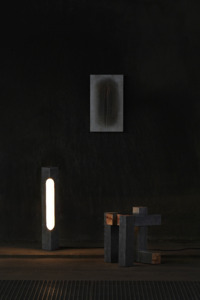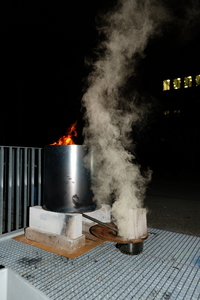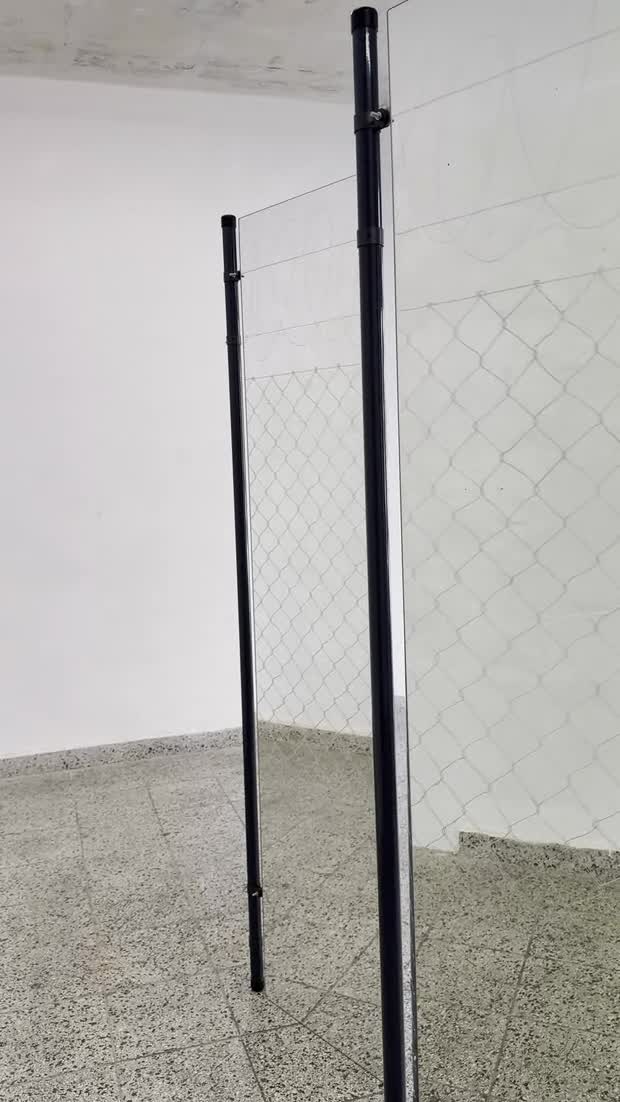AFTER FIRE -SCALE
Benachbarte Sets (4)Alle Zusammenhänge anzeigen
Diese Sets wurden den gleichen Sets hinzugefügt wie das ausgewählte Set.
4 Inhalte
- Seite 1 von 1
FLAME SPRAYED
- Titel
- FLAME SPRAYED
- Autor/in
- Beschreibung (de)
- FLAME SPRAYED
Metall und Holz sind einander nicht fremd. Eisennägel halten seit Jahrhunderten Holzstücke zusammen. Aber was passiert, wenn diese uralte Verbindung aus einer mechanischen zu einer alchemistischen Einheit wird? Die Antwort liegt nicht in der mittelalterlichen Zauberei, sondern in einem industriellen Hightech-Verfahren. Das Metallflammspritzen geht auf Beobachtungen zurück, als Munition mit den Objekten verschmolz, auf die sie abgefeuert wurde, und hat sich zu einer Technik entwickelt, die in spezialisierten Werkstätten vor allem für den Korrosionsschutz von Metallen eingesetzt wird. Bei der Arbeit mit einem Metallsprüher fielen mir die Holzabschnitte auf, die als Träger für die besprühten Objekte verwendet wurden, sie wirkten wie metallisiert.
Der Spiegel, die Lampe und der Hocker der Serie FLAME SPRAYED reflektieren die hybriden Eigenschaften des Materials: Eine spiegelartig polierte Holzmaserung, ein in Stücke geschnittener Balken mit offenen Enden und eine leitfähige Holzoberfläche, die als Schalter fungiert.
- FLAME SPRAYED
- Beschreibung (en)
- FLAME SPRAYED
Metal and wood are no strangers to each other. Iron nails have been holding pieces of wood together for centuries. But what happens when this age-old bond gets transforms from a mechanical to an alchemical unison? The answer doesn't come from medieval wizardry but from a high-tech industrial process. Metal Flame Spraying dates back to observations, when ammunition fused with the objects it was fired at, developed into a technique that sits tucked away in specialised workshops primarily used for metal corrosion protection. Working with a metal-sprayer, I noticed the sacrificial wood offcuts being used as supports for the sprayed objects, and was caught by their unexpected appeal when seemingly metallified.
The mirror, lamp and stool of the series FLAME SPRAYED reflect the hybrid properties of the material: A mirror-like polished wood grain, a beam cut into pieces with open ends and a conductive wooden surface that acts as a switch.
- FLAME SPRAYED
- Kategorie
- Typ des Projekts/Werks
- Schlagworte
- Datierung
- 2023/24
- Material
- Abmessungen
- Mirror 57 x 33 x 3 cm, Stool (open ends) 49 x 40 x 40 cm, Lamp 100 x 12 x 12 cm
- Ort
- ?
- Stadt
- Land
- Bemerkungen
- Mein Projekt FLAME SPRAYED hat im Afterfire Seminar WS22/23 begonnen (Januar 2023 Projekt start) und ist danach zu einem freien Projekt geworden, an dem ich jetzt noch arbeite.
- Titel
- FLAME SPRAYED
- Projektleiter/in
- Studiengang
- Importiert am
- 07.06.2024
- Übergeordnete Sets
- 1
- Set enthält
- 0 6
After fire- birch pitch
- Titel
- After fire- birch pitch
- Untertitel
- birch pitch
- Autor/in
- Beschreibung (de)
- Was kommt nach dem Feuer? Für das menschliche Auge unsichtbar, ist Harz in allen Hölzern enthalten. Durch einen sauerstofffreien Erhitzungsprozess wird das Harz als eine dickere Substanz extrahiert, die einem schwarzen Kunststoff ähnelt, der als Teer oder Pech bekannt ist. Seine Verwendung reicht viele Jahrtausende zurück und dient verschiedenen Zwecken, von
medizinischen Anwendungen bis hin zur Abdichtung und sogar
als Klebstoff.
Mit besonderem Augenmerk auf die Birke als einheimischen Baum sollten die historischen Ursprünge der Teergewinnung aufgedeckt werden. Dazu musste ich die mühsame, langsame und meditative Erfahrung der Birkenpechgewinnung nachempfinden, d. h. im Wald nach Birkenbäumen suchen, die Rinde ernten, einen Teerofen bauen und immer wieder versuchen, den Teer zu gewinnen. Die Herausforderungen und Misserfolge wurden zu einem wesentlichen Bestandteil des Erfolgs meines performativen Ansatzes für diese Erfahrung.
- Was kommt nach dem Feuer? Für das menschliche Auge unsichtbar, ist Harz in allen Hölzern enthalten. Durch einen sauerstofffreien Erhitzungsprozess wird das Harz als eine dickere Substanz extrahiert, die einem schwarzen Kunststoff ähnelt, der als Teer oder Pech bekannt ist. Seine Verwendung reicht viele Jahrtausende zurück und dient verschiedenen Zwecken, von
- Beschreibung (en)
- What comes after fire?
Invisible to the everyday eye, resin is delicately infused in all woods. Through an oxygen-free heating process, the resin is extracted as a thicker substance, resembling black plastic known as tar or pitch. Its use dates back many millennia, serving various purposes, from
medicinal applications to waterproofing and even
as an adhesive.
With a specific focus on birch as a native tree, the aim was to uncover the historical origins behind tar extraction. The process involved replicating the laborious, slow, and meditative experience of birch pitch production, which included seeking out a secluded patch of birch trees, harvesting the birch, constructing a tar-making oven, and making repeated attempts to extract the tar.
At times, I succeeded only in obtaining a few drops,
while at other times, I managed to fill a jar. The challenges and failures became integral to the success of my performative approach to this experience.
- What comes after fire?
- Kategorie
- Typ des Projekts/Werks
- Schlagworte
- Datierung
- wintersemester 2022 2023
- Mitwirkende
- Dank an
- Sprache
- Material
- Technik/Verfahren/Formate
- Beamer oder Tablet
- Stadt
- Land
- Titel
- After fire- birch pitch
- Importiert am
- 14.06.2024
- Übergeordnete Sets
- 1
- Set enthält
- 0 7
After Fire_ Birch Chair
- Titel
- After Fire_ Birch Chair
- Titel (en)
- Birch Chair
- Beschreibung (de)
- Birch Chair follows a holistic approach and combines modern and traditional birch processing methods. Seats are molded and glued in the same way as the main use of birch wood today in veneer panels. All legs are milled.
Wood joints are clued with birch pitch created from the bark by thermal energy of the smaller knots.
The resulting black outlines on the iconic round joints are an analogy to a traditional way of working with fire as a tool.
- Birch Chair follows a holistic approach and combines modern and traditional birch processing methods. Seats are molded and glued in the same way as the main use of birch wood today in veneer panels. All legs are milled.
- Beschreibung (en)
- Birch Chair follows a holistic approach and combines modern and traditional birch processing methods. Seats are molded and glued in the same way as the main use of birch wood today in veneer panels. All legs are milled.
Wood joints are clued with birch pitch created from the bark by thermal energy of the smaller knots.
The resulting black outlines on the iconic round joints are an analogy to a traditional way of working with fire as a tool.
- Birch Chair follows a holistic approach and combines modern and traditional birch processing methods. Seats are molded and glued in the same way as the main use of birch wood today in veneer panels. All legs are milled.
- Kategorie
- Typ des Projekts/Werks
- Schlagworte
- Datierung
- 01.04.2023
- Mitwirkende
- Material
- Stadt
- Titel
- After Fire_ Birch Chair
- Projektleiter/in
- Studiengang
- Importiert am
- 14.06.2024
- Übergeordnete Sets
- 1
- Set enthält
- 0 0
Plastic Chair
- Titel
- Plastic Chair
- Autor/in
- Beschreibung (en)
- Vivian Reuter explores in her project the perhaps uncomfortable reality that we, primarily in the global north, are burning trash as a form of energy.
Known as “waste-to-energy”, the process of burning municipal waste to generate energy has grown rapidly across Europe as a solution to our waste problem. The incineration of trash in countries like the Netherlands, Denmark, and Germany is often portrayed through technological lenses as the exact opposite of its chaotic waste input: orderly, efficient, and clean. Incineration plants designed by prestigious names like Bjarke Ingels paint the image that this energy source is rightfully part of our new energy transition.
Perhaps unusually, waste incineration is largely considered a form of renewable energy, helping nations achieve climate targets. This should raise some eyebrows given that within the incinerated trash are large amounts of petroleum based products, such as plastics. Notably, about 1.1 tonnes of CO2 is emitted per tonne of trash; this is nearly 70M tonnes of CO2 emitted in the EU per year.
Reuter chooses to draw attention to this contentious space through the exploration of the iconic plastic outdoor chair.
By the mutilation of the iconic, playful plastic forms using fire, Reuter creates pieces that are at once attractive and repulsive— the smell and look of burnt plastic inherently makes us think of pollution and even the developing world where images of burning trash abound, such as Ghana’s Agbogbloshie dump. Reuters works seems to challenge waste incineration as having an element of absurdity by transforming the chairs into altogether different objects such as candles, and through the use of a domestic object, reminds us of the cost of our daily activities that are saturated in systems of consumption.
- Vivian Reuter explores in her project the perhaps uncomfortable reality that we, primarily in the global north, are burning trash as a form of energy.
- Kategorie
- Titel
- Plastic Chair
- Importiert am
- 15.06.2024
- Übergeordnete Sets
- 1
- Set enthält
- 0 1


